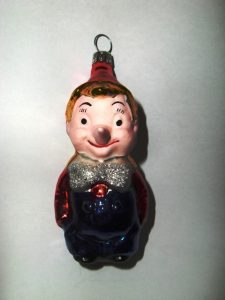Christmas tree decorations from Thuringia: Pinocchio - German/German

Thuringian Christmas tree decorations made of glass have been on sale since the Biedermeier period. In the first half of the 19th century, the Christmas tree was no longer only set up in squares in the cities, but was brought into the "good parlour" of the citizens.
The glass Christmas tree ornaments developed from the fruit and knick-knack figures that the Thuringian glassblowers made on the simple bellows-powered blowing lamp. The figures were then colourfully painted with gelatine dyes and even then exported as far as Nippon, in German Japan.
Two developments enabled a rapid increase in the production of glass Christmas tree decorations: the introduction of the gasworks in Lauscha in 1857 and the production of aniline dyes in the first tar factory founded a year earlier by the English chemist William Henry Perkin near London. In addition, the chemist Justus von Liebig developed silver plating on the inside, which contributed to a gigantic variety of shapes and colours. Figures such as Pinocchio, who grows a long nose when he lies, or Wilhelm Busch's Max and Moritz have enjoyed increasing popularity in recent years. During the annual Christmas exhibition at the Wertheim Glass Museum from 1 Advent to 6 January, they decorate the four-metre-high "Thuringian Figurine Tree".
Thuringian Christmas Tree Decorations: Pinocchio - English

Thuringian glass Christmas tree decorations have been available since the Biedermeier period. From the first half of the 19th-century a Christmas tree was no longer only put on display in town squares, but also in the private parlour. Glass Christmas tree decorations developed from the fruits and porcelain figurines that Thuringian glassblowers made with a simple pair of bellows and a blowtorch. These figures were then colourfully painted with gelatine dyes and exported, even then, to Japan.
Two developments made a rapid increase in the production of glass Christmas tree decorations possible: the introduction of the glassworks in Lauscha in 1857, and the production of aniline dyes, which the chemist William Henry Perkin had discovered at the first coal tar factory founded in London in the previous year. This was complemented by interior silver plating developed by another chemist called Justus von Liebig, which contributed to a staggering amount of shapes and variety of colour. Figures like Pinocchio, whose nose grows longer when he lies, or Wilhelm Buschs' Max and Moritz have enjoyed growing popularity over the past few years. During the annual Christmas exhibition at Wertheim Museum of Glass from the first of Advent to the 6th January, these figures decorate the 4 m tall "Thuringian Figure Tree.